14 Best Websites To Sell Photos (2024 Pros And Cons)

Looking for the best websites to sell photos? You’re in the right place.
In this post, we’ll be showing you the best places to list your photos for sale online.
We’ve included a mix of different types of websites, including macrostock and microstock sites, online marketplaces, and ecommerce platforms.
And we’ve included all the information you need to know about each of them, including their pros and cons, payout structures, royalty rates, and more.
The best websites to sell photos – comparison
TL;DR:
The best place to sell photos online is through your own website as you get to keep all your profits. You can build your site and start selling with Sellfy in minutes.
Photodune is the best site for selling stock photos if you’d prefer not to use your own site. You set your own prices and the platform deducts a fee from each of your sales.
Envato Elements is another popular stock photo site. It uses a subscriber-share model so the amount you earn will depend on how often your photos are downloaded.
#1 – Your own website
The best website to sell your photos on is one that you own. And the easiest way to do that is to use Sellfy. You can sell products through an existing website or use the platform to create a store in minutes.
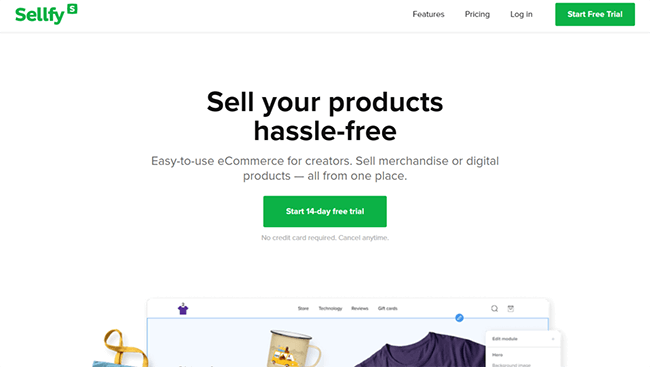
Here’s why selling photos through your own website is a good idea:
First off, you have complete ownership of everything.
When you list your photos for sale on stock photo sites and third-party marketplaces, you’re giving up a ton of control. There may be restrictions on how you can price or license your photos, and you won’t have much control over the way your shop and product listings look
This isn’t the case when you sell through your own site. You can set whatever prices you want, set up your checkout however you want, and have complete control over the way your entire storefront looks.
Secondly, you keep 100% of your profits.
When you sell through third-party sites, they take a big cut of the sales price in transaction fees, so the royalties you get paid are only a fraction of the amount that the customer pays.
In contrast, when you sell through your own website, there’s no middleman, so everything goes to you.
And don’t worry, building your own photography store is easy. You can get everything set up in as little as 10 minutes. All you have to do is sign up for Sellfy, upload your photos to create your product pages, and connect a payment processor. Then, you’re ready to start selling.
The reason we recommend Sellfy is it’s designed specifically for selling digital products like photos, so it’s super easy to use, and it charges zero additional transaction fees.
Plus, it also has built-in marketing tools to help you make sales and even doubles up as a print-on-demand fulfillment service.
This means in addition to selling photos as digital downloads, you can also sell physical products printed with your photos/artwork, and Sellfy will fulfill the orders for you automatically.
And should you need to, you can also sell your own physical products.
Sellfy plans start from $19/month. If you want to connect your own domain, you’ll also need to purchase domain name registration separately. You can get started with a 14-day free trial.
Pros
- Complete control and ownership
- Design flexibility
- You keep 100% of your profits
- You can also sell additional products (like POD merch)
Cons
- Takes longer to get started than third-party sites (requires you to build your website first)
- Harder to make sales (no existing customer base to tap into)
Read our Sellfy review.
#2 – Photodune
Photodune is the best stock photography site for selling royalty-free stock photos. It’s one of the most popular sites for buying and selling photos and has a huge customer base, which makes it easier to make sales.
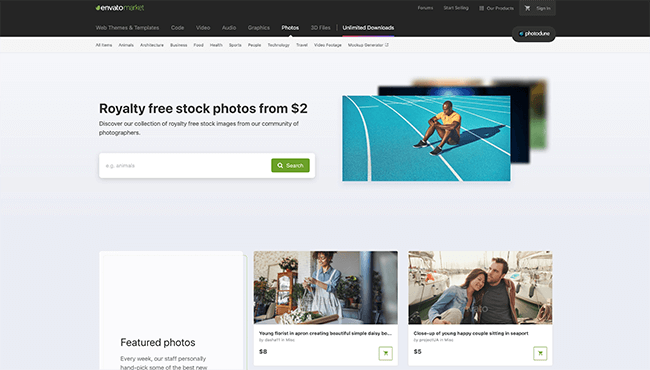
The main reason we like Photodune better than other stock photo sites is that it’s part of the Envato network. And all the sites under Envato’s umbrella have a clearly-defined target market.
They’re mainly aimed at web designers and developers, who tend to buy more and pay more than the general public at large.
Prices vary from seller to seller, but most sell at around $5-$10 for a regular license, or $50-$100 for an extended license, which is higher than most microstock sites. However, Envato deducts an author fee, so that won’t all go to you.
If you sign up as an exclusive author, the author fee charged on each sale will be between 12.5% and 37.5%. If you sign up as a non-exclusive author, it’ll be 55%.
While many photographers have more luck selling on Photodune than other stock sites, it’s still worth keeping in mind that there’s no guarantee you’ll make sales. According to Envato, only 37% of market authors earn money in any given month.
Pros
- Huge customer base
- Clearly-defined target market
- Prices are higher than microstock sites
Cons
- Author fee deducted from list price
- Only 37% of authors earn money per month
#3 – Envato Elements
Envato Elements is another stock photography website under the Envato umbrella. But unlike Photodune, it uses a subscriber-share payment model.

Basically, the difference between Envato Elements and Photodune is the way authors get paid.
It works like this: You sign up as an author and publish your photos on the platform. Any customer who is signed up for an Envato Elements subscription can then download and use those photos for free. They don’t pay for each photo individually.
Earnings are then allocated based on the money collected from individual subscribers and how important your photos were to them. This is where it gets a little complicated.
Envato pays out 50% of the money they earn from subscriptions to their authors, and that 50% is split between all the authors whose items each subscriber used.
So let’s imagine that a particular subscriber only downloads one of your photos and one photo from another author in any given month.
In that case, the money they paid for that month’s subscription will be split between the two of you and Envato—you’ll both earn 25%, and the other 50% goes to Envato. See how it works?
The downside of this model is that you’ll earn a smaller amount each time your photo is used by a customer than you’d typically earn selling them individually.
However, it’s also much easier to make sales this way. According to Envato, 98% of authors that publish on Elements earn money every month (and 99% earn every year). That’s much higher than the 37% of authors that make money on Photodune.
Pros
- 99% of Envato Elements authors earn money
- Huge user base
- Easy to sign up and get started
Cons
- Low earnings per photo
- Can’t set your own prices
#4 – Etsy
Etsy is the best online marketplace for selling photos. It’s a high-traffic global marketplace for unique, handmade, or creative goods, and gets millions of shoppers every month.
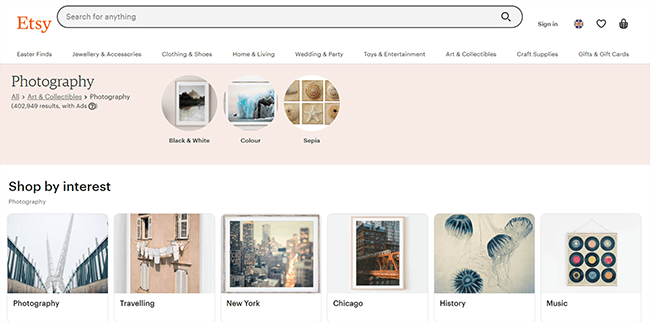
Etsy is another platform with a very clearly-defined target market. Shoppers tend to be crafty young women (86% of their buyers are female, according to a survey) so the photos that sell best are those that cater to this demographic.
Selling on Etsy gives you more control than stock image sites, but still not as much as you’d get selling through your own store.
You can set your own prices so your earning potential is high. And Etsy only takes 6.5% of the item price in transaction fees, plus a $0.20 listing fee per product, which isn’t too bad. Plus, your first 40 listings are free.
You also get to decide what kind of products you want to sell. For example, you might sell your photos as digital downloads and offer different licensing options. Or you might connect Etsy to a print-on-demand app like Printful and sell your photos as physical prints.
It’s free to sign up for Etsy and you can build your shop in minutes.
Pros
- 40 million+ shoppers
- Flexible
- Easy to get started
- Low transaction fees compared to stock photo sites
Cons
- Very competitive
- Not exclusively for selling photos (lots of product categories)
#5 – Shutterstock
Shutterstock is a stock photo website where contributors can sign up for free and upload their photos to Shutterstock’s extensive online catalog, then earn money every time they’re downloaded.
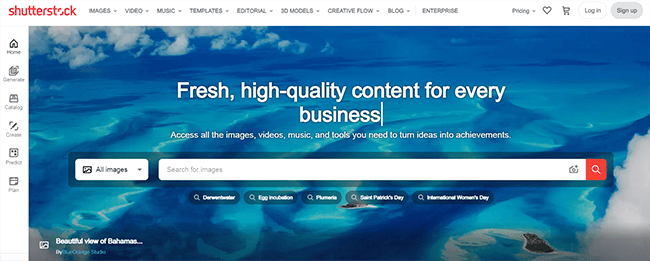
The best thing about Shutterstock is how popular it is. It’s arguably the biggest stock photo site on the internet, with millions of users, and has paid out over a billion dollars to contributors to date.
The downside is it’s also very competitive. With microstock sites like Shutterstock, you’re competing against thousands of other sellers. And you’re also competing against thousands of stock photos that are totally free.
As such, the market rate is pretty low. You’ll have to get a high volume of photo downloads on Shutterstock if you want to make a good income. It’s about quantity over quality.
The commission rate varies depending on the number of licenses you sell per year, starting at 15% and going all the way up to 40%. The more you sell, the more you earn.
Pros
- Easy to get started
- Free to sign up
- Good contributor support
- Incredibly popular (tons of traffic)
Cons
- Low commission rate
- Very competitive
#6 – Adobe Stock
Adobe Stock is another microstock site like Shutterstock where you can sell photos, as well as videos, vectors, and illustrations in a non-exclusive arrangement.
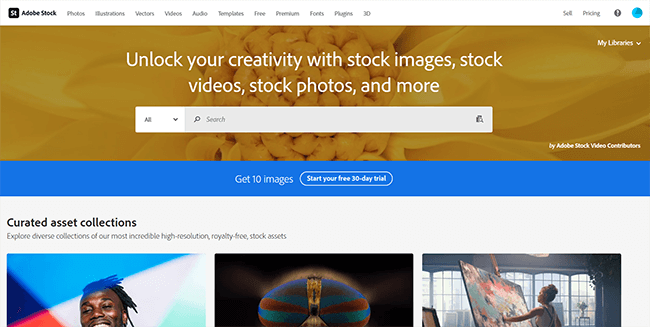
Anyone can sign up for Adobe Stock and start selling. Just sign up with your Adobe ID and upload your photos directly from your computer, or import them from Adobe Lightroom.
You’ll then earn 33% royalties whenever you make a sale, which is toward the top end of what you can earn on Shutterstock.
As an Adobe Stock artist, you also get free access to Adobe Portfolio, which you can use to build your own custom portfolio site and showcase your best work. This is a nice added feature.
Like Shutterstock, Adobe Stock is incredibly popular with millions of buyers. If your photos are high-quality and you focus on a niche that’s in demand, there’s no reason you can’t make tons of sales.
Pros
- Unparalleled reach
- Superb workflow tools
- Adobe Portfolio access
Cons
- Low royalty rate
- Competitive
#7 – WunderPics
WunderPics is the best website to sell action sports photos. It provides a revolutionary way for sports photographers to sell their images to the people they take photos of.
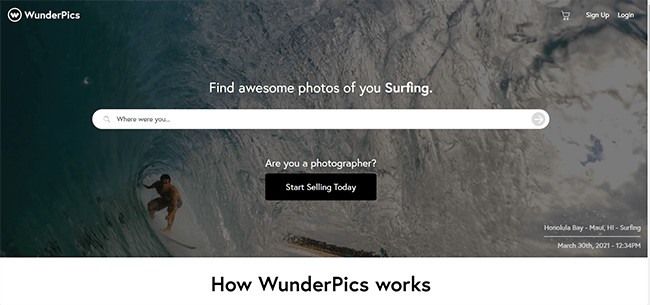
WunderPics is completely different from traditional stock photo websites. It works like this.
First, sports photographers go out and take photos of people in the midst of the action. For example, they might get a great shot of a surfer catching a wave, or a snowboarder shredding the gnar.
Then, they upload those photos to WunderPics and tag them with the relevant location, date, time, and activity.
That way, athletes can easily search for, find, and purchase photos of themselves doing what they love.
You set your own prices and WunderPics takes a commission of 15% from each sale. You can upload 15GB of photos on a free account but if you want to increase the upload limit beyond that, you’ll need to sign up for a paid plan.
Pros
- Revolutionary way to sell photos
- Photo tagging and discovery features
- Fair commission structure (WunderPics only takes 15%)
Cons
- 15GB upload limit on free plan
- Only for sports photos
#8 – Fine Art America
Fine Art America is the best website for selling photo prints. It’s a print-on-demand marketplace for independent artists and photographers.
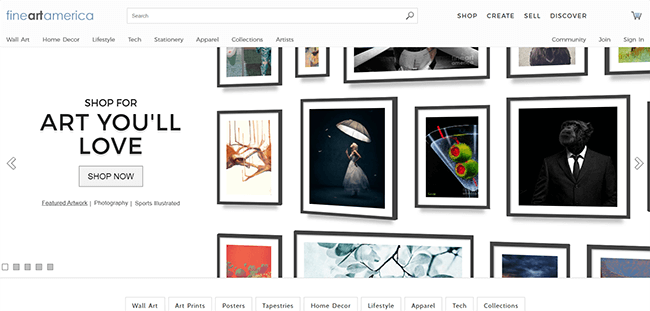
Unlike the other options we’ve looked at so far, Fine Art America is for selling physical photography products, rather than digital files.
Here’s how it works.
First, you open your account (it’s free) and upload your images. Then, you choose what kind of products you want to sell and upload your photos to those products. There are tons of products to choose from, including all sorts of photo prints like canvas prints, framed prints, posters, etc.
After that, you set your prices by adding your preferred markup to the product base cost, and list them for sale on the Fine Art America marketplace. When orders come in, Fine Art America prints and ships the order for you.
Because they handle the fulfillment side of things, it makes it totally hands-off for you as a seller. All you have to worry about is taking awesome photos.
Another great thing about Fine Art America is that their prints are all very high quality. And they ship them from local fulfillment centers around the world, so you can sell to a global audience without super-long delivery times.
Pros
- Sell physical prints and other POD products
- Global fulfillment
- Museum quality
- Sales and marketing tools
Cons
- More for selling photo prints than digital photos
#9 – Displate
If you’re looking for a unique way to sell your photo prints, Displate may be just the platform for you. Displate allows you to sell your artwork and photos printed on stylish metal posters.

These metal posters have become extremely popular on social media over the past couple of years, making them one of the most lucrative ways to sell your photos.
Displate is mainly used to sell artwork, but you can also use it to sell architecture photos, portrait photos, and more.
On Displate, you’ll earn up to 50% of the total sale value of the plates and some large plates sell for more the $100 apiece so your earning potential is sky high. Aside from photos, you can also sell some extra goods too such as 3D magnets and even gift cards.
Pros
- A unique way to sell images
- Displate has a big social media following
- Sell photos or artwork
- High average item price
Cons
- The commission rate is quite high
- Product options are quite limited
#10 – Redbubble
Redbubble is an art marketplace that you can use to sell your photo prints, as well as other types of print-on-demand products. You can print your images on everything from wall art to phone cases, stickers, and more.

As the artist, you’ll be able to apply a markup to the base product cost of each print you sell. Redbubble will keep the base price, and you’ll receive the profit from the markup (known as the artist markup).
The artist markup is set by you, and can also vary based on whether you apply discounts for bulk orders on items. The payout structure is a little complicated, but once you get started it’s quite easy to get your head around.
Although Redbubble can be used to sell your photo prints, it’s more of a POD service than a photography site. However, if you’re looking to sell your work using POD, there are other services available, and profits vary depending on the platform you choose.
Keep in mind that Redbubble has a distinctive quirky aesthetic and a younger target market. So the best-selling photos tend to be those that cater to a younger demographic and break the mold.
Pros
- Sell prints and physical products
- Wide range of product options to choose from
- Set your own markup
Cons
- Markup and pricing system can be complicated
- No options for selling digital downloads
#11 – SmugMug
SmugMug is an innovative all-in-one platform that will allow you to store, share and sell your photos all in one place. The platform is first and foremost a secure storage solution for your digital photos that you can use to share your content with family, friends or clients.
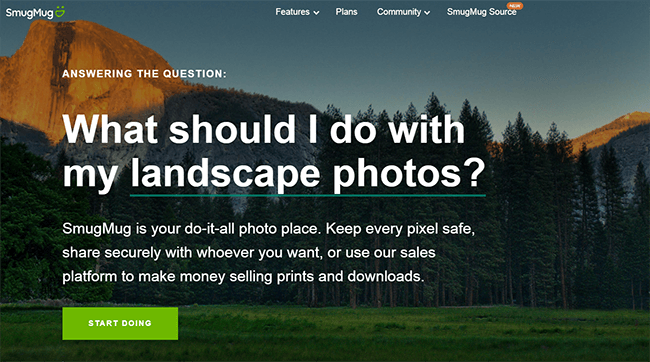
However, SmugMug also plays host to a sales platform that will allow you to sell prints and digital downloads of your images.
With SmugMug, creators get to keep 85% of their sales profit. The profit is classed as the difference between the retail price you set and the default print prices.
For example, the default price of your image may be $0.79, and your retail price is $9.99. The difference between the two ($9.20) is the profit, and you’ll keep 85% of this amount every time you make a sale.
SmugMug allows you to keep more of the profit than some other options on this list. However, you’ll also need to pay for a monthly membership which starts from $16 per month.
Pros
- Keep 85% of the profit
- Can sell prints or digital downloads
- Also a storage solution for your photographs
Cons
- The earnings model is a little complicated
- Monthly membership is also required
#12 – 500px
500px is a photography community that takes a different approach to royalties and licensing than some other platforms.

Instead of charging a fee on sales, contributors to 500px get to keep 100% of the royalties they earn. However, they do have to pay a monthly fee to enjoy 100% royalties.
If this doesn’t sound like the right option for you, then you can sign up to a free plan. However, free plan sales are subject to 40% commission rates on sales. Although this is quite high, it’s still slightly lower than some other popular options.
500px puts a heavy emphasis on image quality and reviews all photos to ensure that they meet the licensing standard, so it’s definitely a good platform for higher-level photographers rather than beginners.
They’ll review elements like image uniqueness, technical quality and execution, overall aesthetic, production value, and commercial viability before approving your photos.
Although this process can be quite frustrating for creators, it ensures that the marketplace doesn’t become oversaturated with poor-quality images, which in turn will boost sales for the best creators.
Pros
- 100% royalty option
- Good choice for skilled creators
- Free plan available
Cons
- High approval requirements
- Not as well known as some other platforms
#13 – Alamy
Alamy is another super popular stock photo site. You can use it to sell individual photos, photo packs, illustrations, and more. Alamy is said to pay out over $1 million every month to contributors and it has over 110,000 customers.

The signup process to sell with Alamy is simple and straightforward and it just requires a few personal details, plus links to your social media profiles if you have them.
Once your account is approved you can start listing your photos and earn up to 50% of the sale price.
For exclusive images, you’ll earn 50% of the sale price. However, if a customer purchases non-exclusive images you’ll only earn 45% of the sale price.
Alamy handles all of the complicated licensing elements and gives contributors a straightforward and hassle-free contract.
Pros
- Easy sign-up
- Popular site with a big customer base
- Photos and illustrations accepted
Cons
- Alamy takes a 50-55% cut of sales
- No options for selling other content types such as video content
#14 – Getty Images
Getty Images is a creative community marketplace that can be used to sell your photos to high-end clients.
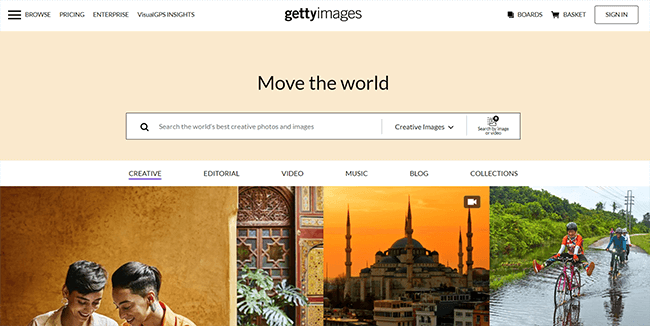
It’s a high-end alternative to a microstock image site, and it helps your photographs to be discovered by publishers, brands, and advertising agencies. It’s one of the most popular sites of its kind and has a large user base.
Unlike microstock sites, customers on Getty Images are willing to pay more for top-quality images, so standards and competition on the platform are high.
You can sell everything from high-end photographs to illustrations and videos on Getty, so it’s a great platform for multi-skilled artists.
To get started with Getty, you’ll need to submit an application of 3-6 images via the Contributor by Getty Images app. The team will then review your application and send you an invite to the platform if you are successful
For every image sold, you’ll pay a commission to Getty. Commission fees range from 20% to 45%.
Pros
- People are willing to pay more for images
- Large user base means good discoverability for your photos
Cons
- Fees can be as high as 45%
- The marketplace is quite competitive
Best websites to sell photos FAQ
How profitable is selling photos online?
That depends on how you price your photos, where you list them (your royalty rates), and how many sales you make.
The most successful photo sellers are able to make six-figure incomes per year. Others are content to make a small side income.
On average, expect to earn around $0.25-$0.45 per sale on cheap micro-stock photo sites, or $5-$50 per sale if you sell prints or exclusive licenses through your own site.
What kind of photos sell the best?
There’s no one-size-fits-all answer to this question. All sorts of photos can sell well if you find the right audience for them and market them correctly.
That said, some of the most popular categories on stock photo sites include travel landscape photos, photos of work environments, photos that showcase diversity and inclusion, food images, and action sports photos.
The best advice I can give here is to take the photos you like to take, and then find an audience for them later. For example, if you enjoy shooting action sports, stick with that, and sell them on a site like WunderPics.
Which stock photo site pays the most?
You’ll get various answers to this question depending on who you ask. Average payouts depend on what kind of licensing arrangement you sign up for (e.g. exclusive or non-exclusive), photo pricing, sales volume, etc.
Personally, we’ve had the most success on Photodune as the royalty rates are reasonably good, you can set your own prices, and it feels easier to land sales compared to other stock photo sites.
Getty Images is pretty good too. It caters to the higher end of the market so it tends to pay out more to contributors than other stock sites.
The lowest-paying stock photo sites tend to be microstock sites that sell a high volume of photos for a low cost. That means sites like Shutterstock and Adobe Stock.
How else can I make money from photography?
Selling photos isn’t the only way to make money from your photography. You could also try selling your services. For example, you could set yourself up as a freelance event photographer and shoot weddings, birthday parties, corporate events, etc.
You could also consider starting a photography blog, joining photo contests, doing freelance photography work for magazines or newspapers, etc.
What other products can I sell aside from photos?
If you’re not having much luck selling photos, there are plenty of other products that you can sell online. Here are some ideas:
- Books and ebooks
- Digital planners
- Print-on-demand merchandise
- Online courses
- Videos
You can check out our roundup of the best digital products to sell online for more ideas.
If you want to focus on real, physical products rather than digital downloads, check out this guide instead.
And if you’re focusing exclusively on selling on Etsy, try these popular Etsy products.
Choosing the best websites to sell stock images
That concludes our roundup of the best stock photography sites.
As you can see, you’re not short of options when it comes to selling photos. There are tons of marketplaces and stock photo sites out there to list them on.
And you don’t have to just choose one. It’s often a good idea to sell your photos on as many sites as possible (as long as they’re not subject to any exclusive licensing agreements) in order to maximize your sales opportunities.
That said, if you just want to focus on a few, here’s what we’d suggest:
- Build your own eCommerce photography store with Sellfy.
- Sign up for Photodune as a non-exclusive contributor.
- Cross-list your photos on Envato Elements.
But if you need more help, check out our tutorial on how to sell photos online.
To explore more ways to sell photos and other digital products online, check out these ecommerce platforms.
And, if you’d like to learn more about ecommerce in general, check out these ecommerce statistics.
Good luck!
Disclosure: Our content is reader-supported. If you click on certain links we may make a commission.
